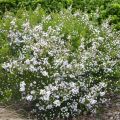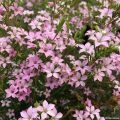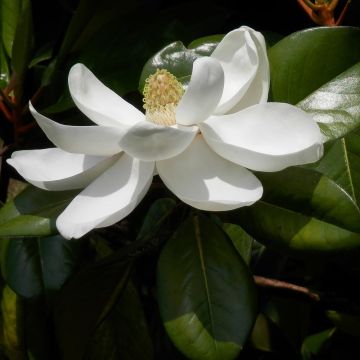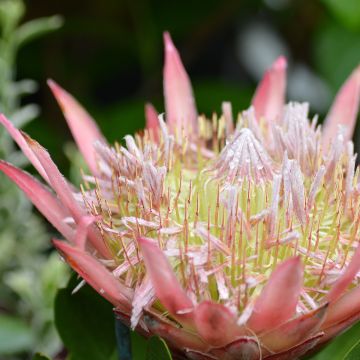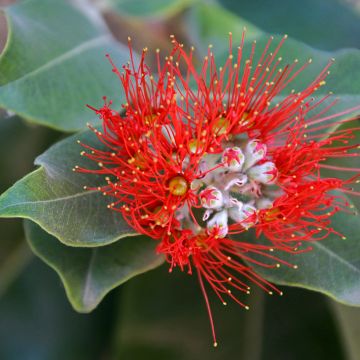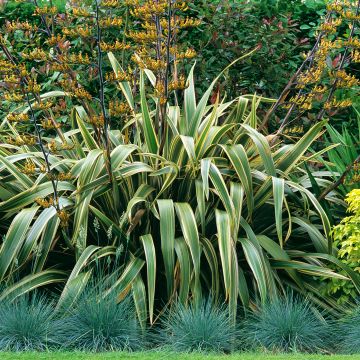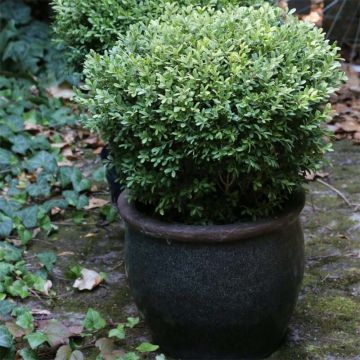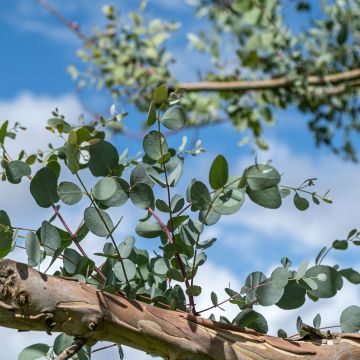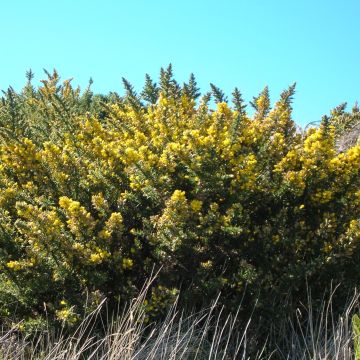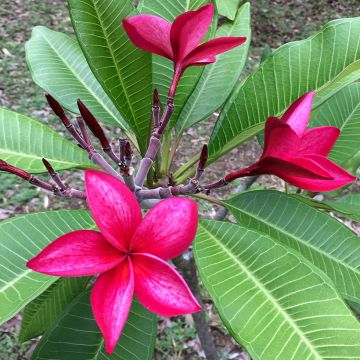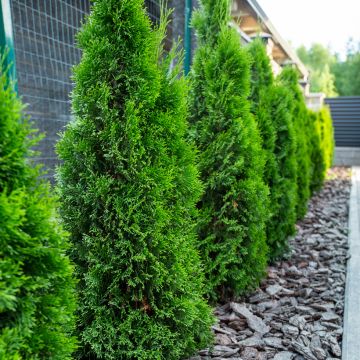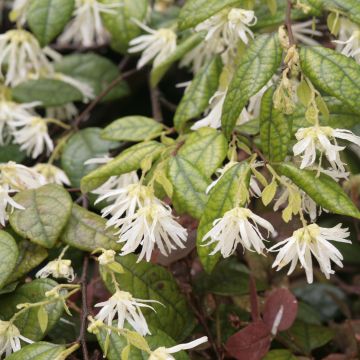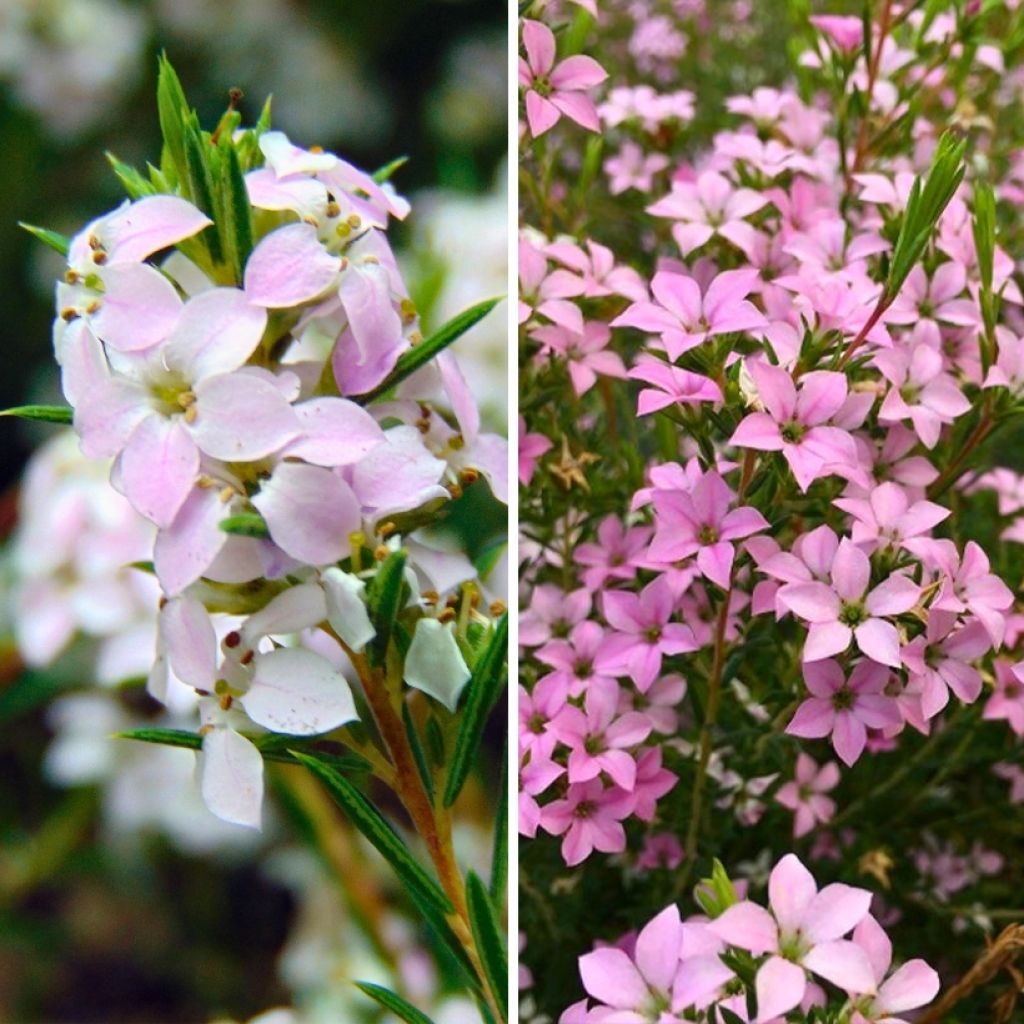

Duo of Diosma - Diosma hirsuta Pink Fountain and Pink Diamond
Duo of Diosma - Diosma hirsuta Pink Fountain and Pink Diamond
Diosma hirsuta Pink Fountain, Pink Diamond
confetti bush
This item cannot be shipped to the selected country
Delivery charge from €5.90
More information
Schedule delivery date,
and select date in basket
This plant carries a 24 months recovery warranty
More information
We guarantee the quality of our plants for a full growing cycle, and will replace at our expense any plant that fails to recover under normal climatic and planting conditions.
From €5.90 for pickup delivery and €6.90 for home delivery
Express home delivery from €8.90.
Does this plant fit my garden?
Set up your Plantfit profile →
Collection items (2 plants)
Description
This pair of Diosma will flower the terrace or a coastal garden for long weeks, between February and June-July. These Diosmas are South African undershrubs not exceeding 45 cm in height and 55 cm in width, beautifully rounded, with evergreen foliage that is reminiscent of heather. They have a surprising spicy fragrance when touched. Their tiny star-shaped flowers bloom in a dense and airy mass. Diosmas are very resistant to drought in open ground and have a great effect in a dry rockery or a gravel bed. Elsewhere, in a planter or a pot, they can spend the winter protected from the cold.
This duo consists of:
1 Diosma hirsuta 'Pink Fountain': pale pink flowers
1 Diosma hirsuta 'Pink Diamond': brighter pink flowers
Diosma hirsuta is a shrub plant native to the Cape region in South Africa, particularly the valleys and slopes of the Cederberg, where it grows on sandy, non-calcareous, well-drained soils. It cannot withstand frost below -5 °C. It is a very pretty plant for ericaceous or sandy soil, ideal for enhancing a bed or a rockery by the sea. These bushes can be associated with heathers or low-growing scrub vegetation such as rockroses, lavenders, thymes, or Teucrium. Leave a spacing of 40-50 cm between each plant when creating the bed, always place the taller varieties in the background so that each one is clearly visible. In most regions, the Diosmas in this duo will make beautiful plants for a slightly heated orangery or veranda.
Report an error about the product description
Plant habit
Flowering
Foliage
Botanical data
Diosma
hirsuta
Pink Fountain, Pink Diamond
Rutaceae
confetti bush
South Africa
Other Diosma
Planting and care
Diosma hirsuta is only cultivated in open ground or in mild climates. It will thrive in light, well-drained, even sandy or rocky, acidic to neutral soil (it does not like limestone). It tolerates sea spray well. Plant it after the last frost. It will flourish in the sun. Under these conditions, it is hardy down to -5°/-6°C and can live for many years. Once well established, it will not need any watering in the summer. However, it will be essential, in regions further away from the sea, to grow it in a large pot to store it during the winter, in a bright but unheated room. To shape it, you can lightly prune the stems after flowering to encourage the plant to branch out.
Pot cultivation:
Ensure good drainage at the bottom of the pot. Use a lightweight substrate, enriched with leaf compost and coarse sand, and add a little slow-release fertiliser at the end of winter. Do not bury the collar of the plant. Water regularly in the summer, allowing the soil to dry out a little between waterings.
Planting period
Intended location
Care
This item has not been reviewed yet - be the first to leave a review about it.
Evergreen shrubs
Haven't found what you were looking for?
Hardiness is the lowest winter temperature a plant can endure without suffering serious damage or even dying. However, hardiness is affected by location (a sheltered area, such as a patio), protection (winter cover) and soil type (hardiness is improved by well-drained soil).

Photo Sharing Terms & Conditions
In order to encourage gardeners to interact and share their experiences, Promesse de fleurs offers various media enabling content to be uploaded onto its Site - in particular via the ‘Photo sharing’ module.
The User agrees to refrain from:
- Posting any content that is illegal, prejudicial, insulting, racist, inciteful to hatred, revisionist, contrary to public decency, that infringes on privacy or on the privacy rights of third parties, in particular the publicity rights of persons and goods, intellectual property rights, or the right to privacy.
- Submitting content on behalf of a third party;
- Impersonate the identity of a third party and/or publish any personal information about a third party;
In general, the User undertakes to refrain from any unethical behaviour.
All Content (in particular text, comments, files, images, photos, videos, creative works, etc.), which may be subject to property or intellectual property rights, image or other private rights, shall remain the property of the User, subject to the limited rights granted by the terms of the licence granted by Promesse de fleurs as stated below. Users are at liberty to publish or not to publish such Content on the Site, notably via the ‘Photo Sharing’ facility, and accept that this Content shall be made public and freely accessible, notably on the Internet.
Users further acknowledge, undertake to have ,and guarantee that they hold all necessary rights and permissions to publish such material on the Site, in particular with regard to the legislation in force pertaining to any privacy, property, intellectual property, image, or contractual rights, or rights of any other nature. By publishing such Content on the Site, Users acknowledge accepting full liability as publishers of the Content within the meaning of the law, and grant Promesse de fleurs, free of charge, an inclusive, worldwide licence for the said Content for the entire duration of its publication, including all reproduction, representation, up/downloading, displaying, performing, transmission, and storage rights.
Users also grant permission for their name to be linked to the Content and accept that this link may not always be made available.
By engaging in posting material, Users consent to their Content becoming automatically accessible on the Internet, in particular on other sites and/or blogs and/or web pages of the Promesse de fleurs site, including in particular social pages and the Promesse de fleurs catalogue.
Users may secure the removal of entrusted content free of charge by issuing a simple request via our contact form.
The flowering period indicated on our website applies to countries and regions located in USDA zone 8 (France, the United Kingdom, Ireland, the Netherlands, etc.)
It will vary according to where you live:
- In zones 9 to 10 (Italy, Spain, Greece, etc.), flowering will occur about 2 to 4 weeks earlier.
- In zones 6 to 7 (Germany, Poland, Slovenia, and lower mountainous regions), flowering will be delayed by 2 to 3 weeks.
- In zone 5 (Central Europe, Scandinavia), blooming will be delayed by 3 to 5 weeks.
In temperate climates, pruning of spring-flowering shrubs (forsythia, spireas, etc.) should be done just after flowering.
Pruning of summer-flowering shrubs (Indian Lilac, Perovskia, etc.) can be done in winter or spring.
In cold regions as well as with frost-sensitive plants, avoid pruning too early when severe frosts may still occur.
The planting period indicated on our website applies to countries and regions located in USDA zone 8 (France, United Kingdom, Ireland, Netherlands).
It will vary according to where you live:
- In Mediterranean zones (Marseille, Madrid, Milan, etc.), autumn and winter are the best planting periods.
- In continental zones (Strasbourg, Munich, Vienna, etc.), delay planting by 2 to 3 weeks in spring and bring it forward by 2 to 4 weeks in autumn.
- In mountainous regions (the Alps, Pyrenees, Carpathians, etc.), it is best to plant in late spring (May-June) or late summer (August-September).
The harvesting period indicated on our website applies to countries and regions in USDA zone 8 (France, England, Ireland, the Netherlands).
In colder areas (Scandinavia, Poland, Austria...) fruit and vegetable harvests are likely to be delayed by 3-4 weeks.
In warmer areas (Italy, Spain, Greece, etc.), harvesting will probably take place earlier, depending on weather conditions.
The sowing periods indicated on our website apply to countries and regions within USDA Zone 8 (France, UK, Ireland, Netherlands).
In colder areas (Scandinavia, Poland, Austria...), delay any outdoor sowing by 3-4 weeks, or sow under glass.
In warmer climes (Italy, Spain, Greece, etc.), bring outdoor sowing forward by a few weeks.

































